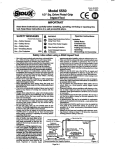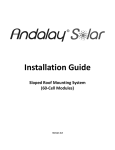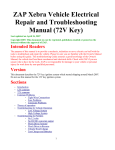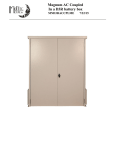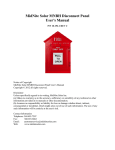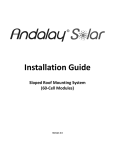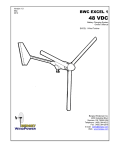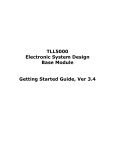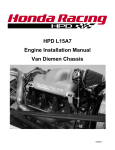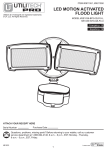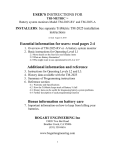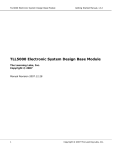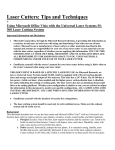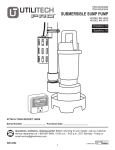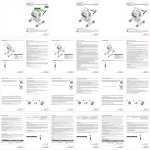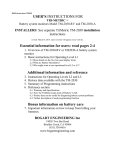Download 5 Solar Years
Transcript
5 Solar Years My solar electric home conversion By Tim Lee Notices: © 2012 All Rights Reserved Worldwide. No part of this publication may be reprinted, reproduced, disseminated, or transmitted in any form by any means whatsoever, whether graphic, electronic, mechanical or otherwise, without prior written permission by the publisher. The contents of this publication reflect only the author’s views. Every effort is made to ensure that the information presented in this publication is helpful and of high quality. No representation or warranties of any kind are made with regard to the completeness or accuracy of this publication. Also, the author makes no representation whatsoever with respect to any results, accomplishments and or actions that may or may not be attained by the reader using the information provided herein. The reader is solely responsible for his or her use of the information contained herein and the author assumes no responsibility or liability with respect to same. The publisher and author disclaim any personal loss or liability caused, directly or indirectly, by the utilization of any information presented herein. The author is not engaged in rendering any legal advice. It is up to the user to meet the safety or code concerns. The services of a qualified “on the premises” professional person are recommended if any such advice or assistance is required to meet such safety and code concerns. All product names and/or logos used throughout this publication are copyrights and trademarks of their respective owners. Copyright 2012 Tim Lee All Rights Reserved 1 Contents Notices: ......................................................................................................................................................... 1 My solar Electric Installation ......................................................................................................................... 3 Building Solar Panels ..................................................................................................................................... 4 The Solar Array............................................................................................................................................ 11 Buying used Solar Panels ............................................................................................................................ 13 Understanding Solar Panel Specifications .................................................................................................. 15 Solar array Wiring and Proper Grounding .................................................................................................. 16 Why use a MPPT solar charger? ................................................................................................................. 21 My charge controllers ................................................................................................................................. 23 Synchronizing Charge Controllers ............................................................................................................... 24 Setting Voltage Limits on your charge controller ....................................................................................... 27 Inverter Search Mode ................................................................................................................................. 27 Power Hungry Appliances ........................................................................................................................... 29 Inverters ...................................................................................................................................................... 31 Loads that have High Current Starting Surges ............................................................................................ 33 Balancing the AGM Sealed Batteries .......................................................................................................... 33 BUSBARS for your Battery Bank .................................................................................................................. 36 Insulating and Making a Battery Box .......................................................................................................... 37 Lightning Arrestors...................................................................................................................................... 38 Power Distribution Blocks ........................................................................................................................... 40 E-Panels and Nottagutters .......................................................................................................................... 41 Your Water Well.......................................................................................................................................... 45 Your Generator ........................................................................................................................................... 48 Proper AC Grounding for Separate Structures ........................................................................................... 48 Beware of AC Multi-Branch Circuits in your Home ..................................................................................... 51 Running Low Voltage DC Power to the Home ............................................................................................ 52 Monitoring your System ............................................................................................................................. 54 Battery Balancer Schematic ........................................................................................................................ 55 Solar trackers .............................................................................................................................................. 56 Sizing your Solar Array and Calculating daily Loads .................................................................................... 57 Calculating the size of the Battery Bank ..................................................................................................... 58 2 Solar Power Facts and Basics Review.......................................................................................................... 61 Online Resources ........................................................................................................................................ 65 My solar Electric Installation In 2006 I went on a long journey. I decided to go totally off grid and convert my double wide mobile home to all solar electric power. I had no advisor but the internet. I had no Installer. I was the installer. What I want to share with you in this ebook are all of the problems and struggles that I faced. How I fixed them and how you can avoid them. This ebook is meant for people who already have a basic understanding of solar power, but if you are new there is a “basics” review in the last section. This ebook may be considered a guide for that transition from basic understanding to a “start building it” level. It will already assume you know how to calculate your daily power usage, size a battery bank and calculate the size of your solar array. If not, I have two chapters in the back and some calculator links in the resources section that will help you out. By reading this ebook you will have a better understanding on how to overcome several obstacles in a solar install. This book covers my off grid journey. Now that I am off grid and not paying for electricity, I truly never want to go back. I love off grid living. By the way, you don’t have to go totally off the grid. I have a friend that only converted his water well because he wanted to irrigate his large garden even when power went out in his area. You can have a grid tie inverter and still reduce your electric bill. You can convert your home in “small steps” by only converting your home lighting, an office area or workshop as a first step. First you must not pay attention to all the hype. Solar Electricity does still cost money. You cannot power an 800 square foot home for under $1,000 dollars. It’s just not possible. At the time of this writing I have spent $15,000 dollars. You can start on smaller projects and save money. So let’s get started. 3 Building Solar Panels My homemade solar panel (1 panel of 20) I want to share with you my epic failure and humbling experience at building my own solar panels. I want to show you how you can avoid my mistakes. Now don’t get me wrong, I don’t want to scare you off from building solar panels. I believe it can still be a cost saving and rewarding experience. So Please read on and learn from my experience. First of all I want to let you know that I have been in the electronics industry for 25 years now. So I have plenty of electronics experience. I figure I’m extremely good with electrical circuits. My soldering ability and handling of the solar cells were not a problem. One day I purchased an eBook that explained how to build a solar panel. It actually was very detailed but had several flaws. After I built twenty solar panels, a major flaw showed up right away. Other flaws showed up later on and the most disastrous flaw a year later. After two years they were pretty much unusable. The 4 worst thing I did was to build twenty panels all at once. It was a massive soldering and assembly line process. These panels were rated at sixty watts each. I should have only built one or two at first to test the concept. The eBook that I purchased showed how to build a panel using a popular air-gap method. Basically you use silicon glue to adhere the solar cells to a bottom piece of acrylic plastic. The acrylic bottom is basically the base. Thin aluminum channeling about a half inch in diameter is used as the surrounding support frame. Then the top cover is a piece of tempered glass. Each panel was sealed with special UV resistant industrial silicon based glue. A large bead of glue was also applied to all four sides of the panel as an extra weather proofing precaution. So each solar panel is basically a sandwich of a top and bottom cover with an air gap in the middle. I remember how exciting it was to connect a 12 volt halogen automotive light to one of my panels and see it glow in the sunlight. I was now hooked on solar electric power. Adding anti-warp bars to panel rear 5 The very first major flaw that showed up was when my panels started warping in the hot summer sun. If I were a mechanical engineer, I would have noticed this flaw even before I started building my panels. The acrylic base of the panels started warping due to a difference in temperature expansion between two dissimilar materials. Since my base was acrylic and my top was glass, my panels started to have a very noticeable bow to them in the hot sun. As panic settled in, thinking the solar cells would soon crack, I quickly consulted with some of my building construction friends. They suggested cutting sections of steel bars to act as a support to the base. Two supports were glued to the back of the acrylic base of each panel. One support was placed towards the top and the other near the bottom. This was agonizing since I had to remove each panel from the ground support frame and work on them one at a time. This support bar fix actually worked and minimized the warping. The second flaw that showed up within a few weeks was fogging in the panels. Since an air pocket was in the panel there were pockets of moisture build up. Usually the fogging went away during the day, but I thought the moisture would eventually corrode the solar cells over time. This fogging was already affecting my power output of the panels. I did some research on the internet and found that other people drilled a small air hole in the panel base at the top and bottom to act as a breather. The hole was only 3/32 in diameter. Fortunately, I could do this while the panels were mounted on the support poles. This worked for a few months, fogging was eliminated, but then the added holes introduced the next flaw. 6 Added PVC pipe dust cover After a few months I noticed dust was getting into my panels. Not only do we have the hot New Mexico sun, but we have wind too. I checked all my panels and scratched my head for a while. After closer inspection, I then realized that the wind was blowing dust into the newly drilled breather holes. I then cut two inch long pieces of PVC pipe that had a cap with a small quarter inch opening on one end. I glued the open end of the pipe over the breather holes. This acted as a tunnel barrier and worked pretty well over time. Dust was pretty much minimized now. 7 Glue separates from inside solar panel edges After a solid year of using my solar panels in the New Mexico weather I noticed rain water was getting into some of the corners of the panels. After much inspection, the super UV proof industrial glue was not as UV proof as claimed. Some edges of the solar panels were now separating. I ended up doctoring each panel with silicon glue on the edges. After two years the panels were separating so much they eventually became unusable. I believe warping was minimized, but added to the glue separation. I have done much research on the best way to make a solar panel. I have since found a new way of building solar panels. I did decide not to try building again with my newfound knowledge. Perhaps my first build was too traumatic psychologically. I will shortly explain what I have found. But first, since I didn’t want to build again, I decided to buy some used solar panels and was able to still save money. If you would like, you can visit my section about tips on buying used solar panels. 8 Now I want to let you know the best way to make your own solar panels that will still save you money. It is called the encapsulation method. Encapsulation has been a more popular method since I have made my air-gap panels. Encapsulation will protect your solar cells from the weather. You may not know, but tempered glass is very fragile on the edges. Accidentally banging the edges of a tempered glass pane can cause a big chip to come out of the glass. That is why, in this method, the glass actually sits in the aluminum frame and actually protects the edges of the glass. The solar cells are placed faced down on a tempered glass plate. After all the cells are properly wired together, a liquid called Sylgard 184 is mixed with a hardening catalyst and is poured over the cells and totally covers them. The frame acts as a boundary for the “pool” of liquid. After the liquid dries, you have a very nice weatherproof solar panel that you have created. So you see that I am not at all against making your own panels. See Sylgard being poured to the back of solar cells in the photo below. You can purchase frames and glass from affordablesolarframes.com. This same seller has a link to three great videos on building solar panels at affordablesolarframes.com/aboutus.sc. The Sylgard 184 can be purchased from ebay. Please see a typical wiring diagram for a 36 cell panel on the next page. Pouring the Sylgard 184 9 Photo courtesy of affordablesolarframes.com/ Typical Wiring of a 36 Cell Home made Solar Panel Minus Plus Terminal Block Blocking Diode Bus wire joins rows Tabbing wire joins individual cells 10SQ045 10A 45V Schottky (easily found on ebay) Single Solar Cell drawn as a .5V battery symbol. Total = 36 NOTES: 1. If using a charge controller, the blocking diode is not needed. The blocking diode prevents battery current from flowing back into the panel during no light conditions. Back current can damage a panel. 2. Find output voltage of the panel. Since each cells voltage adds in a series circuit: 36 cells x .5V = 18 Volts 3. Find wattage of the panel. Each cells wattage adds up. Lets say the individual solar cells are rated at 1.8 watts each. Then 36 x 1.8 = 64.8 watts 4. Find current of panel. Lets say each solar cell is rated at 3.6 amps. Current is the same in a series circuit. Panel amp output is 3.6 amps. 5. Make sure to watch the videos at affordablesolarframes.com/aboutus.sc to see how the cells are soldered and encapsulated. These are probably the best videos on the net showing how to make a panel. 10 The Solar Array My new Mitsubishi panels For an off grid system, and when a new sunny day begins, your solar array must begin to accomplish these three things. 1. It must replace any power that was drained from the battery bank during the previous night. 2. On a typical sunny day, it must be able to bring your battery bank through all three stages of charging. (bulk, absorb and float). 3. It must be able to bring the battery through all three stages of charging and have extra power to operate different types of loads during the day. My solar panel array is currently (after I fixed a problem – next page) rated at 1400watts. My battery bank is a 24 volt bank. It consists of twenty four batteries. They are 12volt AGM sealed deep cycle 120 amp hour batteries. Twelve parallel strings. There are two batteries per string. 11 When my system was running the first two months, I started to notice that there were many days when my battery bank was not fully charged. My batteries were reaching the absorb voltage about once every five days. Uh-Oh….The system was unbalanced. In a balanced solar set up your batteries must come to float state every sunny day. I soon tracked down the culprit, I under-estimated the running time of my refrigerator. Since I set up my system towards the winters end, my refrigerator started to run more often in the warmer summer months. This was one of my “gotchas” after my system was up and running. I soon calculated that my refrigerator was consuming 700 watts within a 24 hour period in the summer months. It consumes about 150 watts while running. During the day my refrigerator was taking away too much precious charge current that my batteries needed. The only way I remedied this was to add another 200 watts of solar panels to my array. My lesson learned was to look at all your load variables. Any load that is seasonal or variable must be included in your system planning. And what about any future loads? Your son just received a gaming system for Christmas. And guess what? It is a 50 watt load and he wants to play it all day long (along with the added 80 watts from the flat screen TV). So make sure you plan for the future too. Another example, one day you want to buy an electric water purifier. It takes one hour to make one gallon of water but it runs at 500 watts of power. There will be a short coming of 500 watts or more to bring the system back to a full charge. Its way better to plan for a little bigger system then to come up short on charging power one day. 12 Buying used Solar Panels My used solar panels – four of them add to my 24V battery bank Advantages The main advantage of buying used solar panels, are the lower price. Since a brand new 200 watt solar panel can cost 1,000 dollars and up, buying a used panel can most of the time be purchased for half or even a third of the price. It is usually a third of the price if you buy three or four at a time. Solar panels come in different grades from the factory. A lower grade panel will cost less and only have cosmetic problems. They will still have the power output specified on the label. The seller should provide the grade of the panel. I also wanted to mention solar panel wattage and voltage matching. A solar array can consist of several solar panels connected in series, parallel or both. It is 13 very wise to have all solar panels match by the wattage and brand name. I would not connect Sharp panels to Evergreen. I would not connect higher voltage panels to lower voltage panels. This is due to the fact that your panel voltage and watts will drop down to the lowest panel specifications and you will not be getting the most power out of your array. If you do have to use a different brand or power rating, then separate those out and buy another charge controller for that particular array. I actually have several charge controllers. One charge controller is fed from my new Mitsubishi panels (each panel rated at 180 watts) and another charge controller is for four of my used Evergreen panels (each panel rated at 205 watts). Just pay attention to what you are buying. Check before you buy. Make sure you are getting all of the same brand or model numbers. This will prevent any future headaches. Disadvantages One reason people buy new panels are for the 25 year warranty. If your used solar panel dies, your normal 25 year factory warranty will not be available (it would be up to the seller to provide and honor any type of warranty). It is probably wise to have a repair fund. Since a homeowner may need cash and sell their panels to a dealer, there may be only a certain quantity of brands and wattage. Depending on what the seller has in stock, this may not fit in with your design plan. 14 Understanding Solar Panel Specifications Pp watts = this is what a salesman will tell you the power rating is. It is a general power rating of the panel. Pp max and Pp min = the power tolerance of the panel. The panel wattage will be between max and min at the specified light and temperature conditions. Vp volts = The voltage you will get at the peak performance of the panel. The only charge controller that can find the peak performance of a solar panel or array during all sun conditions is an MPPT (maximum power point tracking) charge controller. 15 Ip amps = The amount of current that you will get at the peak performance of the panel. Voc volts = The open circuit voltage you will get out of the panel at the terminals under no load conditions. Since this voltage adds up when panels are in series, you must be careful to not exceed the input voltage rating of your charge controller. See the video in my Online Resources section that shows how to check the health of a panel by measuring the Voc. Isc = The current you will get when the solar panel terminals are shorted. Since this current adds up when panels are connected in parallel, you must be careful to properly size your controller so as to get the most power to your loads. See the video link in my Online Resources section that shows how to check the health of a panel by measuring Isc. Solar array Wiring and Proper Grounding The solar array usually consists of several panels connected in series and parallel via sun resistant #10 gauge PV wire. PV wires should never be spliced in order to make longer wire runs. This voids the warranty of your solar panel(s) and secondly it is not NEC compliant. You can purchase #10 gauge extension cables with the proper male and female MC connectors PV on each end. Solar Panels in an array must be of the same brand and model number so as to not cause any voltage drops or imbalances in the output. A PV combiner box is mounted on a PV pole. This metal combiner box contains bus bars and special high voltage DC circuit breakers (note that AC circuit breakers are not allowed in a PV combiner box). Knockouts are provided for lightning arrestor and wire runs. I highly recommend midnitesolar.com for your PV combiner box, breakers and other electrical needs for your solar setup. 16 PV Combiner box from midnitesolar.com The proper way to connect your array is to have each series string on a separate circuit breaker. The negative wire from each series string goes to the negative bus bar in the combiner box. Each positive wire from the string goes to its own individual breaker. All breaker positive sides are connected by a common bus bar that has a terminal for you to connect your larger positive wire for your wire run to the power center. The negative bus bar also has a larger terminal for your larger negative wire that runs to the power center. The advantage of having breakers on each string is so you can have only one breaker on at a time. Then it is possible to check individual string outputs. All the grounds are common in the array and each string can be “removed” from the array by flipping the breaker. This in effect disconnects the positive wire of the string from the array. Since my array is 200 feet from my power center, I check once per year for proper voltage and wattage at the power center by enabling one string at a time in the array. I highly recommend DC breakers instead of using DC fuses in a combiner box. It will make your individual string testing go a lot faster. My Outback charge controller will show the PV input voltage, watts, and current coming in on its LCD display for that particular string. There should not be any large power differences from string to string. It is best to perform this yearly test on a sunny day and when the charger has not reached absorb mode yet. This is a good way to troubleshoot and isolate any bad connections or panel problems. The wrong and improper way to connect your array is to daisy-chain everything 17 together. This is not NEC compliant and not a good practice for combining your array power. See diagram below. Solar panels are grounded through a bare #6 solid copper wire. Small arrays can use smaller gauge depending on the array and NEC guidelines. I recommend #6 for lightning protection. The proper and popular grounding lug type is the ILSCO GBL4-DBT Lug tied to the solar panel with a thread forming 10-32 stainless 18 steel screw as shown in the diagram. This #6 gauge must tie to a ground rod next to the array. Make sure a separate #6 wire also connects between the ground block inside the PV combiner box and the ground rod. Rear frame of Solar Panel Proper solar panel grounding showing ILSCO GBL4-DBT Lug For long runs between the combiner box and power center, a ground wire is connected to the PV array grounding rod and is ran along with the negative and positive PV wires. This ground wire is then connected to the DC ground bar in the e-panel located in the power center. This ground wire will reduce ground potential imbalances between your array and power center that are due to a nearby lightning strike. Ground imbalances can fry electronics. See the wiring diagram below. Inside the power center, the negative battery cable is tied to the e-panel box grounding point or ground bar. The e-panel box is grounded by connecting its ground bar with a #6 bare copper wire that is tied to a nearby earth ground rod. Notice that other equipment chassis ground points will also be connected to the e-panel ground bar as well (chargers, inverters, etc). Keeping all equipment chassis grounds and solar panel grounds at the same ground potential is the 19 proper way for grounding. If a nearby lightning strike elevates the ground potential, then all equipment chassis will be at the same potential. This will hopefully stop equipment damage. Combiner Box Solar Panels QTY 8 Each rated at 24V and 185 Watts Positive Bar DC Breakers + + + + - - - - + + + + - - - - MOV Ground Bar To Power Center Bare #6 Copper Negative Bar Ground Rod driven eight feet into Earth NOTES: 1. Combiner box usually has the ground bar automatically bonded to the combiner box chassis. 2. Solar Panel Wires are usually 10 awg and UV sunlight resistant. 3. Wire gauge from Combiner Box to Power Center is dependent on array size and distance to Power Center (see link to find wire gauge in my Online Resources) 4. MOV is Lightning arrestor 5. Bare #6 awg wire for ground runs to ground rod. 20 Wiring Diagram of my Solar Array Why use a MPPT solar charger? There are two main types of solar chargers on the market. The two most common types are a PWM Solar charger and a MPPT Solar Charger. MPPT stands for maximum power point tracker. I like to think of a solar panel as a variable power source. Output power of a solar panel will depend on the amount of light and the temperature condition in the environment. Of course, we want to get as much power from the panel (even all the up to its maximum power rating on the label). If I apply too much load it will drag the voltage down and I will get less than optimum power. That’s where I highly recommend a MPPT solar charger. This type of charger has a built in program algorithm that can actually sense the maximum power that a solar panel or solar array at any given time. This programming algorithm is running computations many times a second. It adjusts its charging output to obtain the maximum charging amps to your battery bank. When your batteries are low, you want them to get back up to a healthy state of charge as soon as possible. If a cloud hovers over your solar panel(s), then the controller will adjust its output to get as much power from the panel(s) under this cloudy condition. It has been said that a MPPT solar charge controller can get as much as a 30 percent increase in daily power as compared to a PWM charger. 21 The PWM solar Controller The PWM controller is still a very good controller for small system battery charging. PWM stands for Pulse Width Modulation. The solar panel(s) are usually voltage matched to the battery bank. That means that the PWM chargers input is pretty much the same voltage level as the battery. As the battery becomes closer to becoming fully charged, these charging pulses get narrower and narrower so as not to overcharge the battery. If you do buy this type of controller, then I would make sure you can get an LCD display add-on. It is so handy to see charging voltages and amps. More advantages of having a MPPT Solar Charger Another big advantage of having a MPPT charger is the ability to have a higher solar panel voltage on the input. This higher voltage on the input of the charger will be stepped down to a lower output voltage that matches the voltage of the battery bank. I have eight 185 watt Mitsubishi solar panels located about 200 feet from my power center. The power center is where the solar charger is located. The solar panels total array voltage output level is 48 volts. My battery bank is 24 volts. I would not want to have a 24 volt array charging my 24 volt battery bank. There are wire losses from my 200 foot wire run that feeds from my array to the power center. I may lose about 5 volts in the process and the batteries would not reach the absorb stage of charging. That long wire run does have some resistance. The 48 volt array is plenty of voltage and the MPPT charger will step it down to my 24 volt battery bank level. My 24 volt battery bank will enter the absorb stage and sit at a voltage of 28.8 volts for a two hour absorb time. The array will not have any problems charging my battery bank. Another advantage is that most MPPT charge controllers will offer several different battery voltage selections. If I use a 48 volt battery bank, then I only need to make sure my array is at a higher voltage than the battery bank selected. Your charge controller will have a maximum input voltage rating. Since each solar panels Voc will add up when wired in series, make sure to not exceed this maximum voltage rating on the charger or you will damage the charger. You can visit my other section about how to read solar panel specifications. 22 My charge controllers My first charge controller and the least expensive was a PWM pulse width modulator type. It was more for an experiment to try out my home made solar panels and not really for my mobile home conversion. I really wanted to know how a PWM controller worked. That was not a satisfying experience. The controller had a tri-color LED to show each state of charge. I was continually getting out my DVM to check the voltage on the batteries. It would send out charging pulses to the battery bank. As the battery became charged the pulses became narrower and thus kept the battery from becoming over-charged. After purchasing an MX60 controller from Outback Power I saw a big improvement in charging. I would say a 25 percent increase in daily power. It is an MPPT type. I only recommend MPPT types since this type of controller is always adjusting to get the maximum power out of your panels. It has built in software algorithms that continually check for the maximum power point in the array. Another advantage is the ability for these controllers to take higher array voltage on the input. My array is configured for 48V and is 200 feet away from my charge controller. The charging output from the controller to my battery bank is 24V. I only recommend chargers with LCD displays and not just LED status lights. Viewing input and output voltages and watts on a digital display at a glance is very convenient. One new brand of MPPT charger that I purchased for a 12V RV conversion (after my home conversion) had a severe problem one day. This battery bank has six 12 volt AGM sealed batteries in parallel. One afternoon I found out the batteries were boiling internally and were at 19 volts. This brand of controller had a firmware bug that had to do with cold batteries and the charging voltage relationship. It was promptly fixed at no charge by the manufacturer, but was painful to bring the system down. My lesson there was to give a new brand of charge controller at least a year in service to hopefully get the bugs out. Now I 23 only recommend name brand companies like Outback Power, Rogue, Xantrex and Magnum. Synchronizing Charge Controllers Two Mx-60 Synchronized Chargers from Outbackpower.com If you have more than one solar array coming into the power center, it will need to have its own charge controller. Since a new array has its own charge controller, the array can have a different output voltage and can even have a different brand of panels then the first. It does not have to match the other array. Think of this array as its own separate power source. However, this new array must have its own matching panels and also a voltage high enough for the controller to be able to charge the batteries. When two years went by on my solar install, I added another 600 watts of power from a new array. This was due to the fact that I wanted to run some more loads during the day and still wanted my batteries to make it through to a float state every day. My first array uses new 24 Mitsubishi panels and is located 200 feet from the power center. My second array is located about 30 feet away from my power center and has used Evergreen panels from Ebay. This new array is wired very different than the first array and because it was a shorter distance to the power center, it uses a smaller gauge wire run than the first. It actually has four panels wired in series. Care was taken as to not connect too many panels in series and cause the total Voc of the panels (Voc of each panel will add when placing panels in series) to exceed my second Outback chargers input voltage rating. Also, take into consideration that Voc is the highest in cold weather. Both chargers outputs can be wired in parallel and connected to the battery bank. A commonly asked question is how will the chargers interact with each other during the charging process? What if one starts to float and the other wants to absorb? Outback products “talk” to each other via a Hub and control panel called the Mate. The Mate connects to the Hub. Also, the Inverter and Charge Controllers connect to the hub. The Hub is basically a switch that directs communication between the devices. The Mate is basically a control panel and can manage and view Inverter and charger settings. The added feature of the Mate, in this scenario, is to sense the completion of the absorb stage in one charger and then force both chargers into float mode. Each charge controller has a ”battery compensation” setting to compensate for voltage drops in the wires, so make sure to check and adjust (if needed) this setting on each controller. Doing this will ensure each controller senses the proper battery voltage. If you need multiple charge controllers in a solar install, make sure to check your charger documentation for this “forced float” feature. It may even require a call to the companies tech support. 25 Wires from Solar Array #2 Charge Controller #2 DC in Wires from Solar Array #1 Charge Controller #1 DC out DC in DC out MOV MOV 60A x2 PV Breakers 50A x2 To Ground bar in e-panel To Inverter 250A DC Shunt DC E-Panel - Chassis Ground + Battery Busbars Ground Bar Two Charge Controllers in Parallel 26 1. Some wires / devices are omitted for clarity. 2. Connections from Outback Mate are not shown (both controllers need to be connected to Mate for synchronized float control). 3. MOV is Lightning arrestor Setting Voltage Limits on your charge controller The first few days after my home install was completed I realized all of my sealed AGM batteries in my 24V battery bank were making a slight internal hissing noise. As panic started to set in, I got out my DVM and soon realized the batteries were at 29.5 volts and not at 28.8 volts during my Absorb time. After some investigation and internet research I found out the temperature compensation of the charge controller was doing its job and raising the charge voltage when the batteries were cold. I soon found out that I could put limits into the Outback charge controller and not let battery voltage climb over 28.8 volts in absorb mode. This immediately solved the hissing battery problem. Now I recommend limits when using sealed AGM batteries unless the manufacturer specs states there would not be a problem. Before purchasing a charge controller, make sure to download the user manual and check for this limit feature. Inverter Search Mode Some Inverters can be placed into search mode. This mode powers down the electronics in the inverter to save a few watts of running power. The inverter then sends out several cycles of AC power every few seconds. When a load is sensed on the AC line (i.e.: turn on a light) the inverter will switch on to full power mode. When the load goes away, the inverter goes back to search mode. Power savings can add up if no loads are active. If your inverter consumes 20 watts of power in idle mode with no loads, it will consume 160 watts in an 8 hour period. An inverter in search mode may consume only 30 watts in the same time frame. So search mode can have added conservation of your battery drainage. My Outback power inverter has a few settings that can be adjusted in search mode. It has a setting for how often to send out the power pulses. Sending out the pulses less often will save a bit more power. But then you may have the inconvenience of waiting two seconds between turning on a light switch and seeing the actual light turn on. The other adjustment is sensitivity. Meaning how big of a load do you want the inverter to sense before it will turn on and power the load. And here is one of those “gotchas” that fortunately I did not have to 27 experience this problem but do want you to know about. It has to do with your refrigerator. You will not be able to use an electronic fridge in search mode. These types of fridges usually have LED electronic displays. When I went out to purchase my fridge, it had a round mechanical thermostat. That works best for search mode. If you are using an AC refrigerator in your home, it will go into defrost mode every so many hours. The fridge has a mechanical timer motor in it that cycles once a day and switches over to defrost mode for maybe a half an hour. When defrost time is complete the timer cycles back to regular running time. If your inverter is in search mode, when the fridge is not running, the defrost timer may not run properly or not even run at all. Soon your fridge will not be defrosting at all and will not operate properly. I read about lots of issues with this problem on the internet. Many people had to experiment with the search mode sensitivity settings while others re-wired their fridge or even just gave up and ran the inverter out of search mode. Other people were just happy they went with a solar DC refrigerator. (Of course a DC solar fridge is a more expensive option). I decided that I would just go out and get an AC fridge and see what would happen. I looked at the wiring diagram of the fridge, and saw that the defrost timer was wired after the main thermostat of the fridge. This meant that the timer only ran when the fridge ran. My Outback Inverter was able to also sense the timer running in defrost mode. I had to adjust the search mode sensitivity. It is hard to say what different brands of refrigerators will work. Hopefully this gave you a heads up on this common problem with AC powered fridges. It is not an easy problem to fix. I want to mention that many appliances that stay plugged in will not like search mode. Appliances that stay plugged in and have a built in digital clock will continually draw a little bit of power. Some people call this ghost or phantom current. Meaning the appliance takes a very small amount of power while plugged in. For example, your microwave oven has a digital clock. If in search mode my microwave will continually flash at me and of course will not keep the time on the clock setting. The very best way to handle these appliances is to put a power strip 28 on them and turn on the power strip when needed. We do this with our flat screen TV, Washer, dryer and etc. I don’t have an alarm clock that is AC powered. Now days you can get alarms that are battery powered. Some people like to turn on lights on at dusk by using a little motorized automatic timer. Good to give the impression that someone is home when they are away. These may not work with your inverter in search mode. In hardware stores, I have seen digital timers that run on batteries. I highly recommend these for this type of application. Before purchasing your inverter, download the manual and read about the search mode feature. I know some inverters have less adjustment for this mode of operation. So the main point is you will notice a battery power savings while using search mode. Power Hungry Appliances Some appliances are just not meant to be a part of a solar powered home. Our double wide mobile home was purchased from a repo and became our remodel project. Since going off grid was the plan, I immediately got rid of power hungry appliances. The electric water heater (some consume up to 5500watts), electric HVAC system (1500watts and up) and electric cooking stove (1,500watts and up) had to go. Basically, any appliance that consumed long term high wattage had to go. We put in a propane gas water heater, propane cooking stove, propane dryer and a wood pellet stove for home heating. In the summer I converted an old swamp cooler to solar power. We also put ceiling fans in all three bedrooms and converted all lighting to fluorescent bulbs. If you never thought of a wood pellet stove, they are very nice, and legal to put in a mobile home. Pellet stoves usually have two electric fans (a draft fan and blower fan for the room heat). There is also a small electric motor to turn an auger that feeds the wood pellets from a hopper to the fire box. They are not bad on power usage and I highly recommend them. Of course a plain old wood stove is the very best option in a non-mobile home environment (and if wood is plentiful). 29 Something to think about here is the gas cooking stove. A lot of gas stoves have a small electric igniter element and electric gas valve in the lower broiler area. My stove was given to me and had one of these elements. When baking and setting the temperature knob, the electric igniter turns on and consumes about 300 watts. When it is glowing, the valve opens and feeds the gas to the burner under the baking chamber. The gas ignites from the igniter. This igniter will stay on whenever the oven needs to reach the desired temperature. Basically the igniter cycles on and off to keep the oven at the desired temperature. You will see your inverter amp draw go up and down according to this usage. To see if your stove uses this element, open the bottom boiler drawer and you will see the element at the very back of the stove and next to the long gas feeder tube. Since my wife does not do too much baking we decided to keep the stove. The cooking top of the stove has burners that are ignited by a spark generator (those are minimal power, used once for gas ignition and not a concern). The very best option for you to consider would be for an all pilot light type of stove. One day an unknowingly huge appliance showed up on our property. It was my father in-laws RV. He asked if he could use an extension cord and hook up to my system for the night. With no thought what so-ever, I connected him up. I never even looked at my power meter to see what amps were being drawn from the battery bank. As morning came my batteries had dropped to 50 percent of charge. A normal set-up would not let the batteries drop by 30 percent every night. I immediately disconnected that RV and explained to dad that his RV was power-hungry. That actually went well and Dad understood. So the lesson learned is to watch out for those extra loads! 30 Inverters Pure Sine Inverters Inverters that are used to power electronics and appliances are called a pure sine inverter. This inverter is a bit more expensive, but can power sensitive electronic equipment with no problems. This inverter has an output that mimics the waveform of the AC power grid on a typical home. Appliances with digital displays usually work very well with this inverter. Washers, dryers, microwave ovens, computers, internet modems and appliances with digital readouts should work fine. My Outback inverter is a pure sine inverter. Modified Sinewave inverters The other type of inverter usually costs less and is called a modified sine wave inverter. Basically the output looks like a staircase waveform (square). Most appliances without electronics behave fine and are not bothered by this waveform. This inverter works well with power tools (without electronics), hairdryers, heaters and fans to name a few. In the initial design stages of you systems you need to decide on what battery bank voltage to use, since this will decide what input voltage range of inverter to use. The most popular battery banks are 48 volts. It is actually more efficient to invert higher input voltages. (See chapter on sizing your battery bank). After you have calculated the maximum loads that you will be powering, you can decide on what wattage of inverter to purchase. Make sure to not limit yourself on Inverter power. It would be wise to be able to run at least two high power loads at once. My two highest power loads are a microwave oven and the well pump. Grid Tie Inverters Another popular inverter is the grid-tie. It is often called a grid interactive inverter. This type of inverter will not operate in a stand-alone mode and needs to run with grid power present. It has to be tied in to your home utility grid power. This inverter has a safety feature that will turn off the grid tied output if there is a power outage in your area. This may not stop a technician from knocking on your door to make sure the inverter is actually off before they work on a power line. 31 Also, before making the decision to go grid tied, check with your utility on what rules and regulations they have for you to make some money by selling your solar power back to their utility grid. Grid tie inverters have an AC output that is synchronized to the AC waveform of the grid. When the solar panels supply power to the inverter, the inverter will first supply power to the loads in the home to offset your power use from the grid. Any extra power coming from solar panels will be “sold” back to the grid. Grid tie inverters have a higher input voltage range on their inputs. This means more solar panels wired in series and the need to be high voltage safety conscious. Inverter points of consideration Some points were discussed earlier. The main points of choosing an inverter are. • • • • • 32 Voltage input range that is within range of source (Batteries or solar panels) AC Voltage output (60 or 50hz and 120 or 220VAC) Maximum wattage. Amount of surge in watts for so many seconds. Search mode capable for the stand alone types. Loads that have High Current Starting Surges An important part of choosing an inverter is not to only picking the correct operating input voltage and wattage range, but choosing the maximum surge that it can handle. Most inverters now days have high startup surge capability. Some of the worst surges are created when you first turn on a power tool. The worst are electric saws (some have 4,000 watts surge), air compressors, electric motors and pumps. Refrigerators and freezers can have a 1500 watt surge. Since it is sometimes hard to measure surge current on a device, (especially a motor) I always like to recommend inverters with high surge current capability. Most inverter brochures will state surge in watts. You really don’t want your power tool to turn off your inverter, because the inverter can’t handle that start up current. Make sure your inverter can handle a surge for more than just a few milliseconds. Surges can last up to 500 milliseconds or longer as a motor starts to turn. Balancing the AGM Sealed Batteries Right side - Twenty four AGM sealed batteries (each 12V@120AH) 33 Notice the small battery balancer circuit boards wired across each battery As the months went by with my solar install, I started to notice many of my 12 volt batteries had higher voltages than the others. My bank is 24 volts. I use two batteries in series to make one series string. I had twelve of these strings in parallel with a total of 24 batteries. I knew that the batteries I had (sealed type) were not supposed to be equalized. I knew that equalizing was good for flooded types of batteries. But I did not know why some batteries in the string had higher voltages during the absorb time. In a string, one battery was 13.9V and the second (in the same string) was 15.2V. I started to realize that some batteries were “charging hogs” and sucked up more power than the others. After doing some research, I realized my batteries were becoming unbalanced and that battery life could be prolonged if I had a way of balancing them out. There are two popular methods used for battery balancing. One is called a shunt and the other a shuttle. If I put a shunt (or a resistive load) across each battery, and cause it to turn on when the battery is above 14.8V, it will shunt more current through the other battery that has not reached 14.8V. The shunt will stay on until its battery voltage comes back down to 14.8V. 34 The shuttle method charges up capacitors using the higher voltage battery as the source and then switches it or shuttles it over and discharges the capacitors into the battery with the lower voltage. This fast switching action continues until both batteries in the string are balanced. As you can see the shunt method is good during the absorb time only. The shuttle method will work during any mode of battery operation. The shuttle method will keep the batteries balanced even during battery discharge. I owned and liked a shuttle type of baIancer called the PowerCheq. It was expensive and is not being made anymore. Because of the expense, I opted to design a shunt type of balancer due to its lower cost. I used a simple op-amp comparator circuit, voltage reference diode, FET and used a power resistor as the shunt. I have used this circuit with my bank for two years now and am very happy with the results. I wired one shunt between the positive and negative terminal of each battery. I believe this shunt would be compatible with individual batteries up to 150 amp hour ratings. Any larger battery may have to have the resistor value decreased and the FET amperage rating increased. There is a potentiometer to adjust the threshold voltage. This will let you decide at what voltage the resistor shunt will be activated. I have found that not all batteries need a shunt. Some batteries are a little bit more hogs at charging and deprives the other battery in series. I chose to put a shunt on every battery just in case. I only recommend shunts for Sealed AGM deep cycle batteries. In flooded lead acid, equalizing once a month by using the solar charger usually fixes any imbalances. The schematic and parts list for this shunt is in the back of this ebook for you to build for your system. If you do not wish to build a balancer, I would leave it up to you to do some research. I would only buy one or two at first to check them out and see how they perform on your system. A simple check every day during the bulk and absorb cycle with a multi-meter will let you know how balanced the batteries are. I need to mention here that the installer for my friend’s water well never mentioned battery balancers for his set-up. I actually was surprised. And I think the installer should have known. I made 4 balancers for my friend and it fixed his bank in a week. He has four 12 volt batteries wired in series for a 48 volt bank. 35 BUSBARS for your Battery Bank Two bus bars from Stormcopper.com While doing my research and before I started my solar install project, I kept running into people that kept complaining about the cables on their battery banks. Too many people were stacking cable upon cable on their battery posts. Cables were getting loose from posts, things just looked messy. Using battery bus bars for a multiple battery string system is what I installed and I highly recommend. Basically you have one tin plated copper plate for the positive side and one for the negative side. You can purchase them with holes that are threaded or non-threaded. You connect each strings battery cable to the proper plate. Make sure the hole in the lugs on the battery cables are the same size as the holes in the copper plate. You can purchase these copper plates from stormcopper.com. One added cost that must be done when using the bus bar system is to keep cable lengths the same on all strings in order to reduce varying voltage drops in the battery bank. So the closest batteries to the busbars will have the same cable lengths as the farthest batteries from the busbars. This is an added cost but will help all the battery strings to charge and discharge equally. 36 Also, because you are using multiple strings in the bus bar method, individual battery cables can be a smaller gauge than the gauge that connects from the bus bar to the e-panel box. For example, I use 2/0 gauge cable for my individual strings and 4/0 gauge for my connection between the two busbars and the epanel. I highly recommend battery cable from cobrawire.com. My power center is a 6 x 12 cinder block shed. The batteries are on three 2x8 wooden shelves. There are 8 batteries on each shelf. The busbars are mounted above the shelves onto the wall of the shed. Make sure to place some type of insulating panel (I used a block of wood) as a spacer between the busbars. Then you won’t accidentally short the bars if one day you need to use a wrench on one of the copper plates. You may even want to place an acrylic plastic cover above the busbars for safety. Stormcopper does sell insulating covers for the bus bars too. Busbars String 1 String 2 Sample Bus Bar Diagram for 24V bank (for my bank - continue to add strings until there are 12 total) Insulating and Making a Battery Box I chose not to make a battery box for my install. I also know that sealed AGM batteries don’t out-gas under normal operating conditions and I also knew 37 that my batteries do not freeze at 32 degrees. However, I know that my battery bank does lose capacity when they are at freezing temperature. My cinder block shed is insulated and I don’t have to worry about too many freezing temps in the shed. I have learned to adjust to the lost capacity during very cold weather and just don’t use as many loads. Also, it is not good for any battery to be in summer time 100 degree heat for long periods of time. My shed does pretty well in the summer. Sealed AGM batteries can be out of a battery box and there is no need to vent any gases from my shed or from a battery box. I think in the long run, I would have either liked to have made a box for my battery bank or improved on the power shed insulation. My friend made a battery box and used plywood for the box and Styrofoam sheets for insulation. So I would leave it up to you if you want to build a box for your battery bank. The main advantage would be the added stability in battery capacity by having a more controlled temperature environment. I highly recommend protecting your batteries from temperature extremes in the summer and winter months. Lightning Arrestors Using lightning arrestors is a must in any solar install. Even if your area occasionally has an electrical storm, you should not be skimpy on using them. It never hurts to have too much protection. My power center or power shed is in the backyard about 10 feet behind my mobile home. It is common practice to have an arrestor at the solar panel PV box and also inside the power shed at the input to the solar charger. Basically any power cable pair input that enters the power center must have an arrestor and any power cable pair that leaves as output (whether AC from an inverter or DC from the battery) must have an arrestor. I have seen sparks jump between a wire pair that was only 15 feet long due to a nearby lightning strike. That wire pair happened to go to my internet modem. Yes, the modem fried. The lesson learned is to not only put surge arrestors on solar power cables, but also on any telephone pairs and TV coax entering the home. Inverters and charge controllers that are UL listed are usually 38 rated to withstand between 2000 and 2500 volt surges. It would be best to keep these surges lower than the equipment ratings by adding more MOV devices. I currently use Delta lightning arrestors in my solar set-up. I have also added some MOV devices for extra protection. After I saw a video on the new arrestors from midnitesolar I want to recommend using these new devices in your solar install since they incorporate robust MOV devices. The midnitesolar arrestors have an array of self-contained MOV devices with an operational status indicator LED. I use smaller gas tube type arrestors for phone lines and coax that I purchased off of Ebay. Inside the home, make sure that any power strips are the surge protected types. This will be added protection against transients inside the home. Lightning Arestor from MidniteSolar 39 Power Distribution Blocks Long wire run from PV Combiner box of solar array. Enters power center from 200ft of buried conduit. Smaller #6 wire to breaker in e-panel and then to charge controller. Smaller #6 wire from DC breaker on Mom’s RV Battery bank. Larger cable travels 50 ft outside of power center to power DC appliances in Mom’s RV. Cable exits power shed through buried conduit pipe. 40 Power distribution blocks are very handy for converting one wire gauge to a smaller more usable wire gauge (or visa-versa). Distribution blocks can have the added feature of having multiple wires on a terminal side. For example, I have a long run of 1/0 gauge wire coming into the power shed from my solar array that connects to a distribution block. I had to use this thick cable due to the fact I wanted low DC resistance on my power cables coming from my solar array that is 200 feet away. Of course my solar charger can’t handle that huge gauge of wire, so I used a distribution block to come down to a #6 gauge wire that goes to the charge controller. A surge protector can be connected to the same #6 gauge side of the power block because it has multiple wire capability. Power distribution blocks will keep your system looking neat and clean. New and used Distribution blocks can be found on Ebay. E-Panels and Nottagutters DC E-panel for all your D.C. wires from midnitesolar.com 41 Two Outback chargers Midnitesolar E-panel Outback hub Rogue Charger for Moms RV Outback FX Inverter Outback Mate Xantrex Inverter for Mom’s RV Plywood Base Ground Bar 250 Amp Battery Beaker DC Shunt PV input and Charger breakers Inside the E-panel 42 A piece of half inch plywood is usually the foundation for mounting electrical boxes, charge controllers and inverters. This plywood is properly anchored to cinderblock or wall studs. In my install, I used a piece of plywood (varnished for weather protection) mounted to my cinderblock wall of my shed. One thing that I searched for on the internet was how to enclose a majority of my electrical connections for safety and protection. This enclosure should contain dc breakers for my charge controller and inverter, busbars for surge protectors and amount point for the shunt. I found that an e-panel from midnitesolar was the perfect choice. In fact there are now many more e-panel choices for inverters and also box sizes at midnitesolar. One unusual product that is available from midnitesolar is the nottagutter. It is a rectangular shaped box that can be placed in between charge controllers and inverters. My install could have a better way of hiding and enclosing wires and a nottagutter would have been good for me if it was available back then. One thing that I have done was added a second charge controller to my plywood foundation. Since my original foundation was filled up, I had to bolt down another for my charge controller. So I do recommend making your mounting foundation large enough to incorporate any future additions. Nottagutters incorporate busbars to help with heavy DC cabling 43 Wires from Solar Array Charge Controller Chassis Ground DC in DC out DC Breakers MOV AC Junction Box in Power Center Inverter 50A 60A H DC IN N GND 250A DC Shunt for current measure DC E-Panel - + Battery Busbars Ground Bar Important: Battery negative to ground is a NEC regulation Ground Rod in Power Center 44 Important: DC ground and AC ground tied to same ground rod is a NEC regulation My E-panel Wiring Your Water Well If you have a water well on your property, it will most likely be a very power hungry appliance. They are 220V and have a high starting surge and high running watts. The running watts will depend on how many gallons per minute it can pump. A hard decision that I had to make was to decide if I was going to use an AC well pump or go to an all DC setup that uses a water storage tank. A friend of mine recently did a solar conversion on his AC well pump. One of the fortunate things about his property is that he already had a water storage tank that was installed by the previous owners, but for some reason it was not used in the water line set-up. My friend cleaned it up and then had an installer come out and replace his deep well AC pump with an AC/DC pump. This pump fed the storage tank. The installer fitted the tank with float switches to control the high and low levels. Another DC pump took the water from the storage tank and fed a pressure tank that pressurized the water to the home. This whole set-up is DC solar friendly and is run by 200 watts of solar panels. I was considering this option for my 24 volt system. What I eventually decided to do was to pull out my old AC pump and install a Grundfos SQ/SQE pump. These pumps have a soft start feature and that means my inverter doesn’t have to have a super high surge current that are common with well pumps. The only thing I had to do was install a psx-240 step up transformer (available from Outback Power) between the inverter and the pump. The pump is 220V and my inverter 120V. To make this system inverter search mode friendly, I actually ran the two pressure switch wires back to the power shed. When the pressure switch closes, it actuated a 120V contactor relay that in turn supplied current to the step-up transformer (see diagram). The inverter came out of search mode when it sensed the coil of the contactor, powered up the transformer and then turned on the well pump. The well pump feeds my pressure tank. For me this was the easiest choice to implement. If you do lots of irrigation or have a large garden, I would recommend the tank method. When my pump runs, I do see the wattage go up to about 1500 and my amp draw at about 60. This will last several minutes while the pressure tank is filling up. 45 PSX-240 Pressure switch activates contactor. Wires that go out of the shed to pressure switch gets a fuse. MOV 46 PSX-240 photo Courtesy of Outback Power Autotransformer 120VAC Neutral To 220VAC Well Pump 120VAC Hot 5 Amp Fuse Contactor has 20Amp or more contact rating and 120VAC coil Outback PSX-240 MOV Well Pressure Switch By using a 120VAC contactor (available at your electrical supply store), you can still keep the inverter running in search mode. The transformer will not draw any idle current. When the pressure switch activates the contactor, the inverter will come out of search mode and power the step- up transformer. The pump will turn on and fill up the pressure tank. The pump will turn off when the high pressure setting is reached and the pressure switch will open causing the contactor to deactivate. The inverter will go back to search mode. 47 Using a Step-Up Transformer to power your well Pump Your Generator In an off grid install, having a generator is a must. There can be too many cloudy days in the winter. Since there are so many brands and wattages of generators, I did not want to suggest any particular brands, but want to let you research that. I do have a few things to mention. There are some generators that run at 1800 rpm. I have understood these are quieter and more reliable than the 3600 rpm types. I have a Coleman 3600 rpm 5000 watt. It is noisy but I don’t mind and the neighbors are not that close to complain. My carburetor does freeze up sometimes in the winter, so make sure you get a heater option. I go outside with a hairdryer (works good, by the way, to unfreeze that carb), but is still a pain. One of the regrets that I have is not running my generator in a shelter. I use an umbrella set-up when there is snow or light rain (I know it’s not great, but works). I know that was a big mistake not having a shelter and wanted you to be aware. Also, make sure to ground the frame of your generator to earth ground. Some generators run on unleaded fuel, some diesel and others propane. I don’t mind running to the station to fill up a gas can. If you use propane in the home, I would consider a more permanent set-up by using a propane generator and running another propane line to the propane tank. Calculate your generator wattage by how many loads you will run and by how many watts your inverter will use to charge the batteries. We use the generator to charge the batteries and most of the time to catch up on laundry since we never do laundry on a very cloudy day. Proper AC Grounding for Separate Structures This chapter, I hope, will clear up some confusion on AC grounding. Even if you are converting a home in the boonies where no one may care about inspectors, you would still want it to meet code for safety reasons. If you wanted to sell it one day, a shabby install may cause future problems. Even if you are using an installer, most installers like to work with the customer and it does not hurt to exchange knowledge. And, I always advise getting wiring diagrams (AC, DC 48 and grounding) from the installer for your future reference. My friend had an installer for his water well solar conversion. The installer left without offering any type of wiring diagram. Make sure to always get proper documentation. Even a block diagram is better than nothing. My off grid system has a power shed containing batteries, chargers and inverters. This is a somewhat common solar install. I would consider my mobile home a separate structure. Since my mobile home contains all of my AC loads and the power shed contains the inverter, how should it be properly grounded to meet code? There are two common approved solutions. Method one: This is the solution I used. My power shed has its own ground rod to earth and my mobile home has its own ground rod to earth. Each ground rod is located under the AC breaker box. Each metal AC breaker box has a ground terminal that has a wire that runs to the ground rod. In the power shed, the ground on the AC output side of the inverter has a ground wire that runs to the ground terminal in the AC breaker box. There is a bond (or connection) between the white neutral in the breaker box and the ground terminal. In the mobile home, there is a bond between the white neutral wire and the ground terminal in its breaker box. In this method, only the hot and neutral wires are run between structures. Since I only use 120V in my mobile home, I only had to run two wires from the power shed to the mobile home. If you have 220V running to your home, it will have three wires (two hot and one neutral). If you are an electrician, you will notice this is the same practice the utility companies use. Only the hot and neutral wires are brought to the house. See Diagram below. 49 Home Breaker box Power Center Breaker box From Inverter Hot Hot Neutral Neutral Ground Ground Bond Bond Ground Rod Ground Rod Earth First Method Method two: In this method, the neutral would still be bonded to my earth ground in my power shed, but would not be bonded in my mobile home breaker box. In the mobile home breaker box, a separate and isolated (not connected to the metal breaker box) bus bar is required so the neutral conductors can be isolated from earth ground. A ground wire is connected between the two AC breaker box ground terminals in each location and will also travel along with the hot and neutral conductors. For my home, there would have been three wires between the power shed and mobile home (hot, neutral and ground). For a 220V home there would be four wires. I recommend this solution if there is a long distance between structures. If a lightning strike is closer to one structure than the other, there is a possibility of a raised ground voltage at one location. Since both ground rods are tied together this will equalize the ground voltage at both structures and avoid burning out any electronics. I chose solution one for a lower cost method and because my power shed is directly behind my mobile home. All wire gauge sizes must be to chosen to meet 50 the National Electric Code. Note that distances between structures will also affect the wire gauge of each conductor. Home Breaker box Power Center Breaker box From Inverter Hot Hot Neutral Neutral Ground Ground Bond Ground Rod Ground Rod Earth Second Method Beware of AC Multi-Branch Circuits in your Home Multi-wire branch circuits are wired differently from “home run” type wiring in that only one neutral wire is used to provide the neutral-return path for each circuit connected to both phases of the AC grid. This method has been used by electricians in recent years to keep construction costs down while also saving copper and labor costs involved in running a separate neutral conductor for each circuit. In a home that has these circuits, a very serious hazard occurs when connecting a 120V inverter across both the L1 and L2 lines. Normally in a grid connected home, 220 volts is between the L1 and L2 hot lines. L1 and L2 are 180 degrees out of phase with each other and so the neutral of a multi-branch circuit has a proper current rating due to L1 and L2 out of phase. When connecting your 120V inverters output to both L1 and L2 (it is a common practice if there are no 220V loads inside the home) a fire hazard can exist due to the L1 and L2 currents 51 adding up in the multi-branch neutral. If you are not sure if you have these multibranch circuits in your home, have an electrician take a look. Unfortunately, it is not easy to correct these circuits without ripping out drywall and re-wiring the neutrals on these outlets. One solution (added cost) would be to add (stack) a second inverter for a 220Volt system. Then L1 and L2 lines can be out of phase once again. Running Low Voltage DC Power to the Home One of the regrets that I now have and may want to soon rectify is not having a DC wire run from my battery bank to my mobile home. Right at the moment I have all CFL fluorescent lamps throughout the whole house. The only incandescent lamps that exist are inside the fridge and dryer. I have noticed that LED (light emitting diode) lighting is starting to come down in price a bit. And now I would like to install some LED lighting. LEDs can use lower power than fluorescent lamps and have the added advantage of lasting up to ten years or more. I have not installed any in my home as of yet, but have worked with LED’s on many occasions. Watch out for the color spectrum on different brands. I am the type of person that likes bright white output. Different brands of LED’s can have anything from a yellow to blue tinge in their light. The same color spectrum choices come with fluorescent lighting and you will also notice different types of light output. Some fluorescent brands promote soft white, some promote solar (sun) and others bright white. So don’t buy a truck load of LED’s until you’ve tried a few out yourself. A LED flexible strip or light bar has an adhesive backing and also has the added advantage of being able to be cut to length. Some operate on 12V DC and others can operate on 24V. They can be purchased at mouser.com. There are also LED modules and rings for other decorative purposes. Make sure to check the data sheet because these rings don’t usually come with voltage dropping resistors. LEDs are very low voltage devices and individual LEDs need a resistor to connect to 12V or higher. 52 Never (and I do mean never) make a DC run to your home by tapping into a 12 volt battery that is inside a series string on a battery bank. You will unbalance that string very fast. If you have to get 12 volts from a higher voltage battery bank, then purchase a DC to DC converter. Sure it will not be as efficient and use a bit more power, but in the long run you will not create any bank unbalancing headaches. When making a run to the home, use a DC breaker or fuse box at the power center. Make sure to run the wires in conduit. Having a few junction boxes in the home would be a convenience. Run your wires using a minimum of 10 gauge wire to prevent voltage drops. Of course all wire gauge can be larger and should be calculated for distance, amount of loads and meet the safety codes. Only three conductor 15, 20, or 30 amp 240 volt NEMA (style 6-15, 6-20, 6-30) receptacles are allowed for 12VDC outlets in the home. NEMA 125 volt locking style L5-15 or L5-20 is allowed for 24VDC outlets. The ground pin on the receptacle is connected to your ground block e-panel box in the power center by running a third ground wire along with the DC positive and negative wires in the conduit. The ground wire is for ground only and must not be used as another current carrier. Cigarette lighter receptacles or RV type receptacles are not allowed to be used as a DC outlet in the home. Make sure all receptacles match breaker ratings. For example, do not use a 15 amp receptacle with a 30 amp breaker. Some of the other uses for DC power in the home are for a DC refrigerator and a swamp cooler that has been converted to DC power. I did convert my AC swamp cooler to solar power last summer and it uses a DC wire run inside of conduit outside of the home. Update on lighting on 6/12/2012 I have been slowly changing out my CFL bulbs to LED bulbs. The CFL bulbs have only lasted in my home about two years. I decided not to go to the extent of adding DC wiring. The main reasons are that LED bulbs last way longer than CFL and also they are now coming down in price. I need to mention that I was disappointed in Philips brand. They seem to have a turn on delay as compared to 53 the Samsung and Utilitech-Pro bulbs. I like the high lumens of the Utilitech-Pro. They are nice and bright and I purchased them at Lowes hardware. Monitoring your System TriMetric PentaMetric Photos Courtesy of BogartEngineering I use a TriMetric from BogartEngineering.com to monitor my batteries. It has readouts for voltage and charge/discharge amps. It also shows the battery state of charge as a percentage. It wires across the shunt in the e-panel box and the actual unit is mounted in my home. The shunt converts current to milli-volts. These battery monitors will read the shunt milli-volts and give you performance read-outs. It is a great way to monitor your system. Since my install, they have some newer models with added features. I may upgrade to the PentaMetric since it has remote monitoring via the internet. It would be nice to see how things are doing while you are away from home. I do not maintain computer logs of my system and I have heard good reports from a website called greenhousepc.com. They have software called the Green Monitor that is network capable. The software has several levels of pricing 54 verse features, so it is best to review their website. The interface connection is made between your computer running the software and the Mate from Outback Power (or PentaMetric from Bogart Engineering) via a serial cable. If you don’t use a computer, you need to purchase one of their data loggers that run the software. Battery Balancer Schematic This is my circuit that I was mentioning earlier. Pick a time about thirty minutes before the absorb cycle. Wire the balancer across a battery that likes to rise above 14.4V, turn the potentiometer until the LED turns off. When the battery reaches absorb, adjust the potentiometer until the LED turns on just above 14.4V (mine turn on around 14.6-7V). The LED will cycle on and off in normal operation on batteries that like to go over 14.4V during the absorb cycle. The 16 ohm resister will get very warm in normal operation (you may want to raise it off the PCB just a bit). 55 You are free to use this circuit for yourself. But please do not attempt to manufacture it for commercial use. This circuit is my own design and I am only sharing it with people who purchased my ebook. Thanks! Solar trackers Photo Courtesy of Zomeworks Corporation My new solar panels are on frames that use fixed iron poles. I used 3” x 2” angle iron for the frames that hold the solar panels and also used square 4” x 4” iron poles that I purchased from a steel supply depot. They cut them to length for me and I was able to use a friends shop to weld the cut pieces. I made the frames to match the size of my new solar panels. My poles are placed in holes that are three feet into the ground and filled with cement. Since everything was iron, I had to use a good epoxy paint to prevent rust. I drilled holes in the poles and used a large bolt so the frames can swivel. This project cost less than new store bought poles and frames, but it was two full week-ends of work. My used solar panels are mounted on a wooden frame that was easier to build and was less work. On both the steel poles and my wooden frames, I have the 56 ability to change the angle of the frames twice a year to match the suns seasonal trajectory. Since my frames and poles are stationary, I will not get full power all day long. Power will be at maximum when the sun is directly above my solar panels. By using solar panels mounted on solar trackers, you can get an increase of power between 20 to 25% as compared to stationary types. My friend who had an installer convert his water well used a passive tracker from www.zomeworks.com I was impressed with this type of tracker because it uses fluid that expands and contracts in the sun. No electrical motors are involved. This fluid will travel between chambers on each end of the tracker and cause the tracker to tilt and move with the sun. Check out their webpage that explains how it works howtrackers-work. Sizing your Solar Array and Calculating daily Loads Your system size will be based on how many loads you will operate in a 24 hour period. It is expressed in watts per hour or Wh (watt hours). Also, 1,000 watts is usually referred to as 1Kw (Kilowatt). You can find the wattage of appliances on name plates or look up your model on the internet. You may even have to use a clamp on AC amp meter on the hot wire. Watt hours will add up depending on how often you use the appliance or several appliances at a time. For example, if a fluorescent light is operating at 25 watts for only 4 hours per day, that will be 25watts x 4hrs = 100 Wh per day. If I run a flat screen TV that is rated at 80 watts for 4 hours per day, that will be 320 Wh. The total for both appliances per day would be 100 Wh + 320 Wh = 420 Wh per day. Now you know how to add up your loads. Don’t forget any DC loads, including inverter DC operating power and solar charger operating power (See the spec sheets of your Inverter or Controller). It would be best for you to start a list. 57 Now you may ask, what if I run my 1,500 watt microwave for only 15 minutes or 1/4th of an hour per day? That would then calculate out to 1,500 x .25 = 375 Wh per day. Now you see how fast load wattages can add up and how we want to get rid of high power electric ovens and electric water heaters. Some high power items you may decide to just keep. Like a microwave oven, a well pump or the use of power tools in a workshop. You should now have an amount for your daily wattage usage. In the beginning, and after fixing the refrigerator problem, mine was 6,900 watts (6.9Kw) per day for my double wide mobile home. I will use my value for the next calculations. I need to find my daily available sunshine from a solar isolation map here. For New Mexico, mine is an average of 6.77 hours and since I don’t have a solar tracker, it will be more like 5.8 hours of sun (estimation). I now divide 6,900 watts of the power I need by my daily sun of 5.8 hours. That tells me I needed a solar panel array of 1,189.6 watts. To double check the math….1,189.6 watts of solar panels x 5.8 hours = 6,900 watts or 6.9 Kw of power generation per sunny day. I increased my array size to 1,400 watts. Why did I do this? Because of Inverter / charger conversion inefficiencies, wire losses, battery inefficiency and perhaps passing clouds during the day. Those things are a bit more difficult to calculate, so it is best to up the array watts a bit. An array can consist of many panels connected in series and parallel. You can see my basics review section for series and parallel connections. Calculating the size of the Battery Bank You must decide what voltage your battery bank will be. Certainly the most efficient for an inverter will be 48 volts. Mine is 24 volts. The only reason I went with that in the beginning is that I was thinking of a 24 volt DC water well and at the last moment I went with a 220VAC water well pump. Since I did not go with 58 that, I could have been 48 volts. Now don’t get me wrong, I am still very happy with my battery bank. Here are some problems with designing your battery bank voltage too low. If I had a 12V system, my inverter would have to be 12V input and really need a lot more amps to crank out 120V for my high power loads. That means thicker wires and bigger breakers / fuses. I think 24v and 48v banks are more common for higher load applications (like a home). 12 volt systems should be for low and medium power applications like small workshops, travel trailer conversions and other less demanding projects. If I remove the solar panel charging scenario for a moment and just looked at my battery bank, I would see that it would be discharging at 6,900 watts in a 24 hour period. That’s according to my loads. Now I don’t want my batteries to be dead after that 6,900 watt discharge. I actually want them to still be at a 70% state of charge. Keeping them at 70% or above as much as possible will cause my batteries to have a longer life. Dropping below 50% too often will cause the batteries to become sulfated and this will shorten battery life. Deep cycle battery specifications will state how many cycles you will get at what depth of discharge. (Note: In theory….a good 12 volt battery that has been sitting for a few hours at 77 degrees F, without any charge or discharge action, and is reading exactly 12.2 volts is considered to be at a 50% state of charge). If it’s a bit cloudy….I’m sorry but we can’t watch TV tonight because the batteries are going to go below 70% state of charge and they need to last through the night. Do you see what I’m getting at? Batteries will be a big expense and you want to take care of them. Battery specs may not talk about watt hours. They will specify amp-hour rates (Ahr). It is common for battery specs to give an amp hour rate of discharge in a 20 or 24 hour period. If I have a 12 volt battery that says it has a 20 hour rate at 5 amps, that means it will supply 5 amps to your load for 20 hours until the cells are down to a certain very low end voltage (below 12 volts). This battery would be rated at 100 AHr (20hrs x 5amps = 100 AHr). This is also known as battery capacity. This battery capacity would be 100 AHr. 59 So what is my amp / hour discharge for my 24v battery bank? Watts / Voltage = Amps. I can divide 6,900 watts (my loads) by 24 volts and get 287 AHr. Since 287 AHr will be my 30% depth of discharge point, I need to divide 287 by 30% to get my total bank capacity. So….287 / .3 = 956 AHr capacity. Note that some on line calculators will have you divide by .5 or 50%. (Maybe the salesman wants you to come back earlier to buy batteries?). For many years now I try to be conservative at only discharging to 30% (and sometimes discharging to 40%). This has worked for me. Ok, what if it is totally overcast for two days and I still keep any battery charging out of this scenario. Then my amp / hour would double to 574 AHr discharge. And my capacity needed would be 574 / .3 (30%) = 1,913 AHr to still keep my battery bank at a 70% state of charge. Now I know I will not go overboard using power when it is cloudy or overcast. I will tend to really conserve power. Because I found a good price on twenty-four 120 AHr AGM batteries, I decided to go with a 1440 AHr battery bank. 1440 x .3(30%) = 432 AHr of discharge in a 24 hour period. This gives me about another day of overcast when I am conservative on power before I need to bring out my generator. Some people design 3 to 5 cloudy days of extra capacity into their off grid battery bank and if you have the money for some more batteries….. that’s great. So how does this tie in with my solar panel array? Well, the array needs to put back in the bank 6,900 watts each day. If I had two days of clouds, it may take another day to play catch-up depending on how conservative I have been. The amps that I take out of the battery bank needs to be put back in using either your solar array or your generator. Since I have added 600 watts of used solar panels to my system, I don’t have a problem charging my batteries faster after two cloudy days in a row. The used panels were actually bought so my family can play more video games and use computers during sunny days. Faster charging during a catch-up day is just an added benefit. 60 Solar Power Facts and Basics Review Panels When solar panels are wired in series the voltage will add up and the current will be equal to one panel (if panels are same models). Example: Two 18 volt panels rated at 7amps each. Total output is 36 volts at 7 amps. Solar panels that are wired in series are referred to as a string. When solar panels are wired in parallel the current will add up and the voltage will be equal to one panel (if panels are same models). Example: Two 18volt panels rated at 7 amps each. Total output will be 18volts at 14 amps. Solar panel output decreases in power as the temperature rises. Output power is also increased on cold days. Manufacturers usually have a graph that you can refer to that shows temperature to output relationships. When designing your system you must look at total Voc on a cold day. Voc is open circuit or no load voltage. Your charge controller will have a maximum allowable voltage on the input. Exceeding this will damage the controller. Check the solar panel manufacturer specs for Voc verse temperature. Chargers Solar chargers go through 3 stages of charging. They are bulk, absorb and float. 12 volt batteries continue charging (bulk) until it reaches 14.4 volts. This is when the absorb cycle starts. Your charge controller will have a setting to set for how long it will stay in this mode. It is usually one to two hours. I would keep larger battery banks at two hours. During the absorb cycle the charger will keep the battery at 14.4Volts and the charge current will continue to drop as the batteries become more fully charged. If your charger came with a temperature compensation sensor (that is mounted to the battery), the voltage will be higher on cold days and lower on hot days. As discussed before, sealed batteries life can be shortened by over voltage charging. Check battery specs or make sure you can set limits on your solar charger. Flooded batteries are fine and there is no need to set limits. The third charger stage is float and that is right after the absorb cycle. A 12 volt battery will float around 13.6 volts (see your battery specs). On a sunny day, bulk mode starts when the controller senses enough light from the panels and then 61 starts charging the batteries. Absorb should be done by about three o’clock in the afternoon and float should last for the rest of the day. Batteries The two most popular batteries in a solar set-up are deep cycle sealed AGM and deep cycle flooded. The AGM have a glass-matt material soaked in acid. Overvoltage can bubble gasses out of the battery through a special factory vent. So it is very important to follow manufacturer specs and not exceed any parameters (you don’t want gas to escape). AGM batteries can usually charge at higher amperage than flooded and also can withstand freezing temperature far better than flooded. Flooded batteries have to have distilled water added every so often and you must wear safety gloves and goggles when servicing them. Flooded batteries need to have a battery box with a pipe and fan to vent gasses to outside the building. Flooded batteries need to be equalized about once a month in a typical solar setup. Equalization is performed by the controller and it raises the battery voltage past absorb for a determined amount of time. Because of these flooded hassles, sealed AGM are becoming more and more popular. Deep Cycle batteries are extremely heavy (mine are 100 pounds each). Make sure your battery box and supports are strong. My total battery bank weights about 2400 pounds! Typical maximum charge rate of a battery bank is 20% of the total amp-hour capacity. Example: My bank is 1440 AHr. So 20% of 1440 is 288 amps. My peak charge current on a sunny day is typically 60 amps and is well below the maximum. Always consult manufacturer specs. When wired in series, battery voltage adds and the current will be the same as the amp-hour rating of the single battery. Example: Two 12 volt batteries rated at 120 AHr. Total output will be 24 volts at 120 AHr. Batteries wired in series are referred to as a string. 62 When wired in parallel, battery voltage is equal to one battery and the current adds. Example: Two 12 volt batteries rated at 120 AHr. Total output will be 12 volts at 240 AHr. Find the total amp-hour capacity of you battery bank by adding the amp-hours of each series string. Example: I have a 24 volt battery bank, 24 twelve volt 120 AHr batteries and twelve series strings. The total amp-hour capacity is 12 x 120 AHr = 1440 AHr. As temperature drops, battery bank capacity will drop. You will notice this capacity drop on cold winter days. In hot temperatures, battery bank capacity increases, but battery life decreases. I would not let my batteries stay over prolonged periods in environments over 100F. Normal battery life room temperature is 77F. My batteries are in an insulated power shed and the shed can still reach 95F on some days. There is a theory that winter and summer tend to even out battery life. I guess I will see. Never mix new batteries with old batteries. Don’t mix battery brands or models in your battery bank. Your battery bank age or performance will be based on the weakest link and even the oldest battery. So if your bank needs replacing one day, replace all batteries with new (just don’t put a battery load tester on each battery and save the good ones. Use the “good” ones in another project or get rid of them). Totally replace the bank when the time comes. Usually the first signs of a worn-out battery bank are when the capacity just is not there anymore. You start to notice the battery voltage gradually starts dropping lower and lower every night over a period of weeks. Or …….the batteries are not reaching absorb anymore during each sunny day. Don’t let temperature extremes or un-noticed loads fool you. Make sure your loads have not increased for some reason. Also, make sure any wiring has not failed or became loose. When in doubt, buy a battery tester. I wanted you to be aware of another issue about batteries that you may not know about. Removing more amps than the specified 20hr or 24hr recommendation from a battery will actually change the amp / hour capacity of the battery. It will now be less than rated capacity. 63 There is a complex exponential equation for this. It is called the Peukert’s Law. It is beyond the scope of this ebook to discuss this, but wanted you to be aware of it. It is related to higher discharges for longer periods of time. Since I use relatively short periods of high currents (microwave, well pump), I have not really noticed. The main thing that I have noticed is a decrease in battery capacity in cold weather. Safety Solar power can involve high voltage and amps. If possible, shade your panels by throwing some cloth or cardboard over them before working on wiring. Turn off any circuit breakers. Be careful of using metal tools around high amperage battery banks. Make sure to set your multi-meter to what function that you want it to read. When measuring voltage, and then forgetting to switch back to volts from amps measurement will blow the meter fuse. High current will actually vaporize tips of screw drivers and leave holes in wrenches. And lots of big sparks flying around the room can be very scary! Wear safety glasses around flooded batteries. Watch those loads….. this happened on 6/18/2012 My wife accidentally left the water running all night in her garden (first time ever). The water well pump ran all night and I didn’t know it. The batteries dropped to 24.2 volts and the TriMetric power monitor showed batteries dropped to a discharge depth of 55%. That means the pump was cycling all night every 10 minutes and drawing 1500 watts. Ouch! It took all day of sunshine and 5 hours of generator in the evening to bring back batteries to a 75% state of charge. Hopefully, another day of sun will bring them back to the daily float state. I will update this ebook if I find some type of warning device when high power loads are kept running. I may have to design a circuit. 64 Online Resources www.affordablesolarframes.com Frames and glass for your home made solar panels. www.affordablesolarframes.com/aboutus.sc Three great videos on how to make solar panels. Solar Isolation Map Find the daily amount of sunshine in your area. Video - Test solar panels Youtube video on how to make sure your panel is “healthy”. www.outbackpower.com Look under resources for string sizing tool. I own two Outback chargers and one inverter. www.midnitesolar.com There are many products to keep your wiring looking professional. www.cobrawire.com Large gauge battery wire. They sell cable cut to your length. www.stormcopper.com Copper plates for battery busbars. www.powerstream.com/Wire_Size.htm This site has a very good table that I use to find proper wire gauges. Scroll down the page to see it. Use the transmission column amps in the table and not the chassis amps for designing your system. www.mouser.com Find parts for battery balancer. Mouser stocks many electronic parts. Fast and reliable. www.digikey.com Find more electronic parts. 65 www.altestore.com/store/calculators/ Useful solar calculators and parts. http://stores.mavericksolar.com/StoreFront.bok Purchased many parts from this great seller. I also purchased my Inverter and one of my charge controllers here too. He has an Ebay store and is a distributer of midnitesolar parts. www.greenhousepc.com Data logging and internet monitoring. www.bogartengineering.com Battery Monitoring. www.ebay.com I purchased used solar panels on ebay. Find distribution blocks, solar cells, tabbing and bus wire, blocking diodes and various other parts. www.mcmaster.com Super on-line hardware store. They ship fast and I have purchased from them many times. You can even purchase anti-theft nuts for your solar panels. www.roguepowertech.com Reliable charge controller (I own one). Also they now sell data loggers. www.xantrex.com Source for chargers and inverters. I own a prosine inverter that is used for powering my mom’s RV. www.tapplastics.com Source for cast and extruded plastic sheets, rods and tubes. There may be a retail store near you. www.zomeworks.com Source for passive energy products. 66 Thank you for purchasing my ebook. I try my best to review my ebook and keep it accurate. I hoped I have helped you on your way to minimize or eliminate your electric bill. Please feel free to contact me with any comments and especially testimonials to be put on my web sales page. Thanks, Tim Lee www.5solaryears.com This ebook is version 1.40 and is security protected. 67



































































